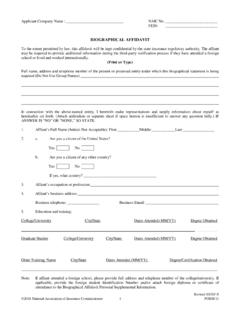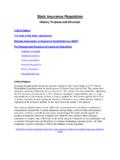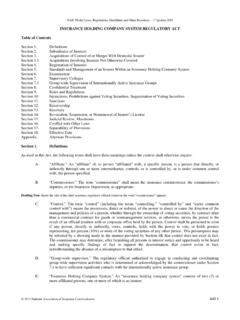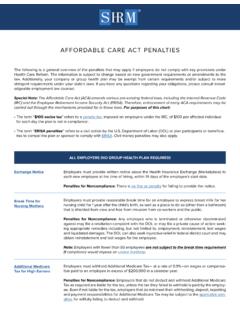Transcription of 2021 Cyber Insurance Market Update - gallagher
1 Market ConditionsFEBRUARY 2021 Management Liability Practice1face of these attacks is a grave concern, it is heightened by the fact that the losses for these organizations are often uninsured, as only 10% of them purchase stand-alone Cyber Insurance policies, according to gallagher Drive Another leading Cyber claim cost driver can be attributed to social engineering schemes that lead to funds transfer fraud. These most often manifest via business email compromise and invoice fraud. The FBI validated this trend when they released their Internet Crime Report in 2020, which indicated that victims sustained $ billion in losses due to business email compromise in the majority of its relatively short life, the Cyber Insurance Market saw rapid expansion and nimbly evolved to meet changing cyberthreats.
2 Cyber Insurance buyers enjoyed expanding coverage terms, plentiful capacity and flat to falling rates in a highly competitive marketplace. However, as we reported last year, the Cyber Insurance Market hit an inflection point in late 2019. Carriers became pressured due to the increasing frequency and severity of Cyber claims and a more stringent regulatory environment at the state, federal and international levels. 2020 began with the first real signs of a hardening Market as the larger, more sophisticated risks in specific industry sectors became subject to greater underwriting scrutiny and ultimately increased premiums.
3 That trend continued and accelerated into the latter half of 2020, and we expect it to become even more challenging in THREAT LANDSCAPE Most Cyber Insurance professionals will agree that the hardening Market is primarily being driven by ransomware attacks. We have seen a disturbing trend, as hackers became more calculating in who they targeted and the amount of ransom they expected to collect, and used sophisticated ransomware variants to execute their attacks. Today s ransomware attacks often target managed security service providers (MSSPs) that frequently act as the outsourced IT vendor to hundreds, if not thousands, of other companies.
4 By attacking them, hackers can impact all of the MSSP s clients in one efficient Cyber attack. Unlike ransomware attacks in previous years, today s cybercriminals have drastically increased their extortion demands by routinely demanding six-figure sums to release data, with occasional extortion attempts reaching multimillion-dollar amounts. Failure to meet these demands often results in threats to release the victim s most sensitive data to the public, as the newest ransomware variants work to not only freeze data, but to also exfiltrate data.
5 This often creates legal liability for the victim company, including mandating notification to affected individuals and regulators, on top of what often results in significant downtime, unforeseen extra expenses and lost business. In fact, a recent study by Coveware revealed that the average downtime due to a ransomware attack is 19 That extended downtime often leads to lost business costs that are exponentially greater than the extortion demand itself. What makes matters worse is that these attacks are disproportionately impacting small and medium-size enterprises that are often least able to defend and mitigate the attack.
6 According to Coveware, 70% of ransomware attacks are aimed at organizations with less than 1,000 employees. While the lack of protection in the THE 2021 Cyber Insurance Market CONTINUES TO HARDEN Author: John Farley, Managing Director, Cyber Practice Ransom Amount Incident CostAVERAGE COSTS BY YEAR201520162017201820193002502001501005 0 Focus on Ransomware Leading Cause of Loss for SMEs$23K$118K$26K$103K$15K$156K$47K$167K $175K$275 KRANSOMWARE THAT INCLUDED BUSINESS INTERRUPTIONR ansomBusiness Interruption (BI)Incident0100200300400 Average $81 KAverage $228 KAverage $342 KMarket ConditionsFEBRUARY 2021 Management Liability Practice2 Several leading Cyber Insurance carriers documented these trends in their own studies.
7 Axis: There was a 404% increase in ransomware demands from 2018 to Beazley: Middle- Market companies (over $35 million annual revenue) were increasingly targeted for social engineering and fraudulent instruction. These attacks Increased from 46% in Q1 2020 to 60% in Q2 Coalition: The most frequent types of losses were ransomware (41%), funds transfer loss (27%) and business email compromise incidents (19%).6 COVID-19 AND INCREASED Cyber RISK FOR REMOTE WORKERSThe sudden onset of COVID-19 forced many employers to pivot to remote working environments, with little time to secure them.
8 Almost immediately, Cyber intelligence sources revealed multiple phishing campaigns aimed at remote workers. Compounding these cybersecurity threats was the fact that many workers operated in an inherently risky ecosystem consisting of personally owned devices, public WiFi, web conferencing platforms and remote desktop protocol that may not have been securely configured. In fact, Insurance carrier Coalition s 2020 claims study revealed that exploiting the remote workforce was the leading cause of ransomware claims during We expect the remote workforce to continue operating well into 2021 and beyond, making this an additional frontier for Chief Information Security Officers to secure.
9 NATION STATE THREATS AND SYSTEMIC Cyber RISK In December, a far-reaching hacking campaign was revealed by top government officials that has been attributed to nation-state actors. Targets included the Departments of Defense, Homeland Security, State, Treasury, Energy and Commerce, as well as several others. The attack extended to the private sector and may impact several thousand organizations. Initial investigation indicated hackers were able to exploit flaws in a widely used software program that provided a back door for access to any company that performed routine updates of the software product.
10 While we will not know the full extent of the attack for several months, the reaction of the Cyber Insurance Market was swift. Within days of the attack, we saw at least one major Cyber Insurance carrier add exclusionary language specific to the use of this software product to be imposed upon policy renewal. INCREASING regulatory RISKF ollowing the trend of recent years, regulators on a variety of levels continue to focus on privacy rights of individuals while flexing their regulatory powers by imposing new data collection and protection requirements, and ultimately levying fines and negotiating settlements for noncompliance.










